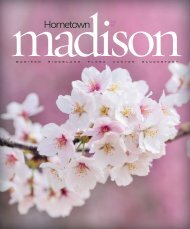Create successful ePaper yourself
Turn your PDF publications into a flip-book with our unique Google optimized e-Paper software.
SNAPPY<br />
One of summer’s most magical offerings<br />
is the flashing lights of fireflies.<br />
What child hasn’t rounded up a Mason jar of lightning<br />
bugs to put in their room? The phosphorous glow is one<br />
of nature’s most fascinating things to watch.<br />
SYNCHING<br />
IN THE<br />
WOODS<br />
Susan Marquez<br />
Now imagine walking into the woods to see tens<br />
of thousands of fireflies flashing their lights in perfect<br />
synchronization. No random flashing here and there,<br />
rather a symphony of lights blinking on and off at<br />
precisely the same time.<br />
The Photinus Frontalis species of fireflies does just<br />
that, and they only do it in dense, old growth forests.<br />
There are very few documented places in the world<br />
where this species is found. One of those places is in<br />
the woods behind the Bill Waller Craft Center in<br />
Ridgeland, adjacent to one of Mississippi’s National<br />
Parks: The Natchez Trace Parkway.<br />
And for the record, fireflies are not flies at all,<br />
they are beetles. And the chemical reaction known<br />
as bioluminescence is how the fireflies convert<br />
energy into light.<br />
The “Snappy Synchs” have a short life span.<br />
They mate, lay eggs, and live about two weeks<br />
before dying. The eggs mature into larvae then into<br />
full grown fireflies that only come out once a year.<br />
The flashing lights are designed to attract a mate.<br />
Once they have mated, their work is done.<br />
Claire Graves, a native of Ackerman, heard about<br />
the Snappy Synchs at the craft center by attending a<br />
class of Mississippi master naturalists. “I have always<br />
been interested in nature,” she says. Similar to the<br />
Master Gardener programs, the Master Naturalists<br />
program trains people to be stewards of our natural<br />
environment and to teach those skills to others. Master<br />
naturalists receive many hours of both classroom and<br />
field instruction, and they are required to complete a<br />
number of volunteer hours along with annual continuing<br />
education requirements.<br />
Hometown MADISON • 55

















